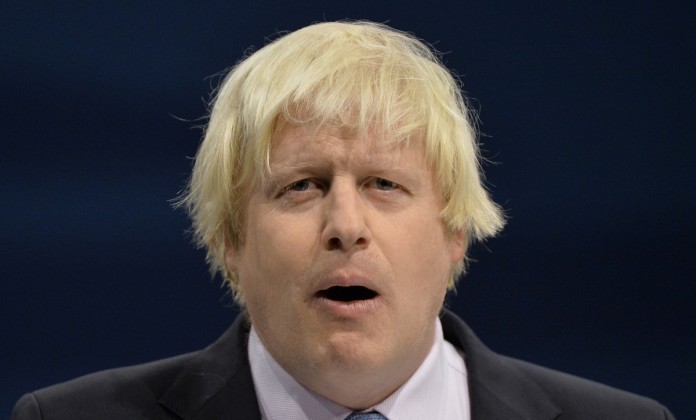
Upheaval in Britain has the world asking questions about political intricacies and oddities that are typically of interest only inside the bubble of Westminster.
British actor Hugh Grant is among those who have been trying to explain. “Dear World, You may be wondering what happens next in terms of the British constitution,” he tweeted. “The answer is that 3 newspaper owners – all of whom are non domiciled in the UK for tax purposes – get together and choose our next Prime Minister or “Poodle”. The Queen then anoints them.”
Grant – not a fan of the British tabloids – was referring to the power and influence of the pro-Conservative Party press. Though his account was intentionally exaggerated, it’s true that a select few will be involved in choosing Britain’s next prime minister. How will the successor to Boris Johnson be determined? Here’s what to know.
– – –
Who gets to vote?
First off: This is not a general election. Most of Britain will be sitting on the sidelines while the Conservative Party chooses its new leader, who will then become leader of the government and the country.
The contenders will be whittled down by Conservative lawmakers in Parliament, with two finalists eventually put to a vote before dues-paying members of the party. Conservatives say they have about 200,000 people on their membership rolls, which have grown some during Johnson’s tenure. Still, that’s less than 0.3% of the population. And certainly not all of them can be counted on to return their mail-in ballots.
Research has found that beyond representing a relatively small portion of the country, Tory membership is unrepresentative demographically. It is dominated by White men who tend to be older and better off than your average Brit. Their pick among the two finalists often doesn’t line up with what polls suggest the broader electorate would decide. Sometimes a prime minister put in place this way needs to call a general election before truly cementing a mandate. That’s what Johnson did in December 2019, after being installed as party leader that July.
– – –
How long will it take?
Conservatives want to announce a winner on Sept. 5 – just under two months after Johnson announced his resignation on July 7. That’s similar to the last transition, when two months passed between Prime Minister Theresa May resignation announcement on May 24, 2019, and Johnson’s installation on July 24.
Based on new Conservative Party rules, announced Monday, any of the party’s members of Parliament who get the backing of at least 20 Tory colleagues can stand in the election. That’s a higher threshold than in the past. Starting Wednesday, the party’s lawmakers will hold several rounds of secret-ballot votes. To make it past the first round, candidates will have to win at least 30 votes. The final two candidates will then be put before the grass-roots members of the party, who will select the winner.
– – –
Who are the candidates?
Leading contenders include Rishi Sunak, whose resignation as chancellor of the exchequer, or finance secretary, helped launch the revolt against Johnson; Penny Mordaunt, a junior trade minister who served as Britain’s first female defense secretary; and Foreign Secretary Liz Truss, who has generated praise for her work during the war in Ukraine and controversy for a relatively hard-line stance on Brexit.
Also in the running: Conservative backbench lawmaker Tom Tugendhat; former health secretary Jeremy Hunt, who lost to Johnson in 2019; YouGov polling founder and newly appointed chancellor Nadhim Zahawi; recently resigned health secretary Sajid Javid; Transport Secretary Grant Shapps; Attorney General Suella Braverman and former equalities minister Kemi Badenoch.
Defense Secretary Ben Wallace had been the favorite in polls of Conservative Party members, but he said that after “careful consideration” he had decided not to run.
– – –
What is a ‘hustings’?
A word that will come up a lot during the leadership contest, a “hustings” is a campaign event, typically involving speeches before voters.
The term has Old Norse origins, combining “hus,” meaning “house,” and “thing” or “ting,” meaning “assembly.” It once referred to the main civil court in London, and then the platform that city dignitaries sat on, and then the platform on which candidates were nominated.
Today, rather than referring to a candidate “on the stump” or “on the trail,” Brits would tend to say “on the hustings.”
– – –
When does the queen get involved?
By tradition, the monarch, as head of state, plays a role at the very end of the selection of a new prime minister, in a ceremony known as “kissing hands” (though in modern politics there is not actually any kissing).
Outgoing prime ministers typically make a last appearance in the House of Commons and then might deliver remarks outside 10 Downing Street, before traveling by motorcade to Buckingham Palace. They are greeted by the queen’s private secretary and led into the private audience room, where they bow and tender their resignation. A departing prime minister and the queen may chat for a bit. But soon the palace releases a statement that the queen is “pleased to accept” the prime minister’s departure from the government.
Immediately after the old prime minister’s car leaves the palace, one carrying the new leader arrives. With a bow or a curtsy, the leader asks for permission to form a new government. When the queen accepts, Britain has a new prime minister.
Queen Elizabeth II has served with 14 prime ministers during her reign. For the induction of No. 15, some traditions may be modified to accommodate the 96-year-old queen, who has mobility issues and no longer spends much time at Buckingham Palace.
(c) 2022, The Washington Post · Marisa Bellack












Macron is next.
Japanese PM Shinzo Abe and the Georgia Guidestone.
What about Elvis?